Imagine the excitement of finding the perfect ring — a dazzling piece that complements your style and reflects a special occasion. But what if, despite the sparkle and allure, the ring simply doesn’t fit? This scenario, unfortunately, has been a reality for many individuals due to the historical lack of size inclusivity in the jewelry industry. Thankfully, this landscape is changing, and the message is clear: everyone deserves to feel confident and comfortable adorning themselves with beautiful jewelry, regardless of their body size.
Here at Modern Gents, we believe jewelry is for everyone and are proud to offer a collection of size inclusive rings designed to fit every body. But beyond making it easier to find well-fitting accessories and clothing, what does size inclusive mean for fashion and jewelry? Let’s take a closer look.
Find Your Ring SizeUnderstanding Size Inclusivity
Size inclusivity is more than a current buzzword. In fashion and jewelry, it signifies the practice of offering more sizes to cater to a wider spectrum of body types. Traditionally, these industries have operated with limited sizing options, often excluding individuals who fall outside the “standard” range. This not only restricts access to desired styles but also perpetuates negative body image and undermines the concept of self-expression through fashion and jewelry. While often associated with people whose bodies are larger than average, size inclusivity also encompasses those who are smaller than average. Recent years have seen a growing awareness of non-inclusive sizing and demand for more inclusive options in both jewelry and fashion. Several factors are driving this shift, including:

- Body positivity movements: These movements have challenged unrealistic beauty standards and promoted self-acceptance, encouraging individuals of all sizes to embrace their bodies and express themselves through fashion and jewelry.
- Diversification of media representation: The inclusion of models and influencers with diverse body types in mainstream media has broadened the perception of beauty and highlighted the need for size inclusive options.
- Growing consumer power: Consumers are increasingly vocal about their desire for representation and inclusivity in the products they purchase, pushing brands to cater to a wider range of body types.
This positive shift towards size inclusivity recognizes the diverse body shapes and sizes that exist and aims to celebrate them. It empowers individuals to find pieces that fit comfortably and flatter their unique forms, fostering confidence and self-love. While it is only one piece of the puzzle, embracing size inclusivity is a step toward building a more accepting and inclusive world.
The Impact of Non-Inclusive Sizing
The consequences of non-inclusive sizing extend beyond the initial disappointment of not finding a well-fitting piece. It can negatively impact individuals, leading to:
- Reduced self-esteem and body confidence: When individuals are constantly faced with limitations due to their size, it can cause feelings of inadequacy and negatively impact their self-perception. Non-inclusive sizing can also make those who fall outside of standard sizing feel like there is something “wrong” with their bodies.
- Exclusion and marginalization: The lack of size options can make individuals feel excluded from participating in certain trends or expressing themselves through fashion and jewelry, leading to a sense of isolation and marginalization.
- Practical challenges and discomfort: Ill-fitting jewelry and clothing can be uncomfortable to wear, causing irritation, restricting movement and even damaging the piece itself. And lack of easy access to brands offering inclusive sizing causes a practical challenge by making it difficult for smaller and larger individuals to find what they need.
Challenges
Despite the growing demand, achieving true size inclusivity in fashion and jewelry remains a challenge. Expanding size ranges increases production costs, especially for smaller brands. This can lead to higher prices for size inclusive options, potentially further marginalizing certain demographics.
In addition, certain clothing styles and jewelry designs may not translate well to all sizes, requiring significant modifications or posing technical challenges. This can also drive up costs. Unfortunately, deep-rooted societal biases about beauty standards and body image can still influence design choices and marketing strategies, perpetuating the exclusion of certain body types.
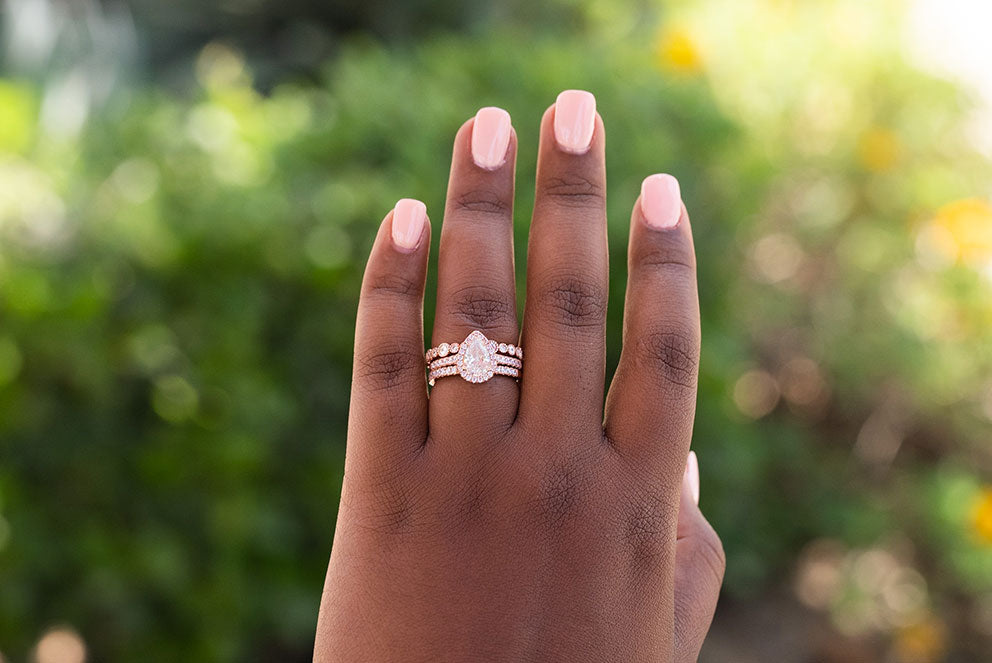
Overcoming these challenges requires a multifaceted approach. Brands need to invest in research and development to create innovative designs and production methods that cater to diverse sizes without compromising quality or style. Additionally, fostering a culture of inclusivity within the industry — from design teams to marketing campaigns — is crucial to ensure representation and address unconscious biases.
Ultimately, size inclusivity in fashion and jewelry is not just about offering more sizes. It’s about creating a world where everyone feels welcome, valued and empowered to express themselves through their clothing and accessories. By acknowledging the challenges and working toward solutions, the industry can move towards a future where style and comfort are accessible to all, regardless of body size.
The Problem with Non-Inclusive Sizing in Jewelry
Most often, clothing is the first thing that comes to mind when one thinks about size inclusivity. However, it’s just as important in the jewelry world. Rings, in particular, present unique challenges when it comes to size inclusivity. Traditional sizing systems often rely on a limited number of whole sizes, neglecting the variations in finger shape, knuckle size and individual preferences. These limitations can manifest in several ways.
Since rings often only come in whole sizes, it’s hard to find one that fits just right. The lack of half sizes or quarter sizes can leave individuals struggling to find a ring that’s right for them. A ring that is too loose may spin or fall off, while one that is too tight can cause discomfort, restrict blood flow and even leave indentations on the finger. Half sizes are, thankfully, becoming more common among jewelers interested in inclusivity, but there’s still a long way to go.
Additionally, not all fingers are the same. They come in various shapes, such as tapered, straight or with prominent knuckles. A sizing system based solely on diameter doesn’t account for these variations, leading to ill-fitting rings that don’t sit properly on the finger.
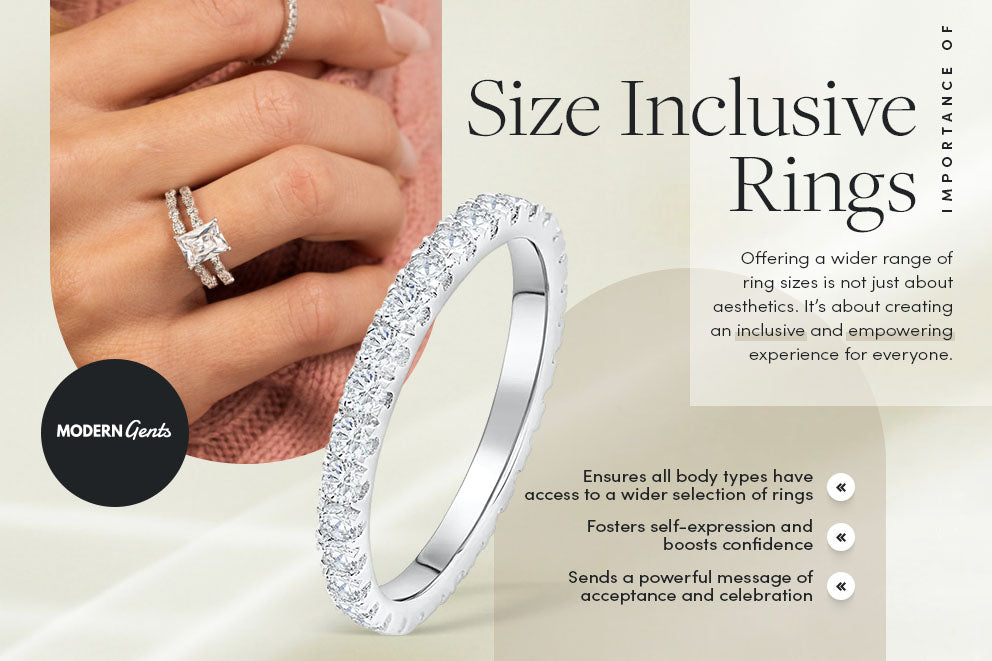
The Importance of Size Inclusive Rings
Offering a wider range of ring sizes is not just about aesthetics. It’s about creating a truly inclusive and empowering experience for everyone. Prioritizing size inclusivity ensures individuals of all body types can finally access a wider selection of rings, allowing them to find pieces that resonate with their personal style and preferences. And when people can find rings that fit comfortably and complement their unique features, it fosters a sense of self-expression and boosts their confidence.
Committing to size inclusivity goes beyond simply checking a box. It requires a conscious effort to dismantle the narrative that certain body types are the norm while others are somehow excluded from the realm of self-adornment and personal expression. By making a conscious choice to offer a broader range of sizes, we send a powerful message of acceptance and celebration, reminding everyone that they deserve to feel beautiful and confident in their own skin. This seemingly small act has the potential to ripple outwards, creating a more inclusive and welcoming place where everyone feels valued and can express themselves authentically.
Addressing Specific Ring Needs
The need for size inclusivity goes beyond offering a wider range of standard sizes. It’s also crucial to address the specific needs of various ring wearers:
Pregnancy Rings
During pregnancy, finger size can fluctuate due to fluid retention. Pregnancy rings offer a temporary solution, providing a comfortable fit and preventing damage to cherished jewelry while accommodating an expectant mother’s changing body.
Engagement Rings
Shopping for a perfect engagement ring is a momentous event, but limited size options can overshadow the joy. Retailers and designers can bridge this gap by offering engagement rings for women in extended sizes, ensuring everyone has access to this symbol of love and commitment. This may involve expanding their inventory to include smaller and larger sizes, as well as offering custom-made options for people with unique size requirements.
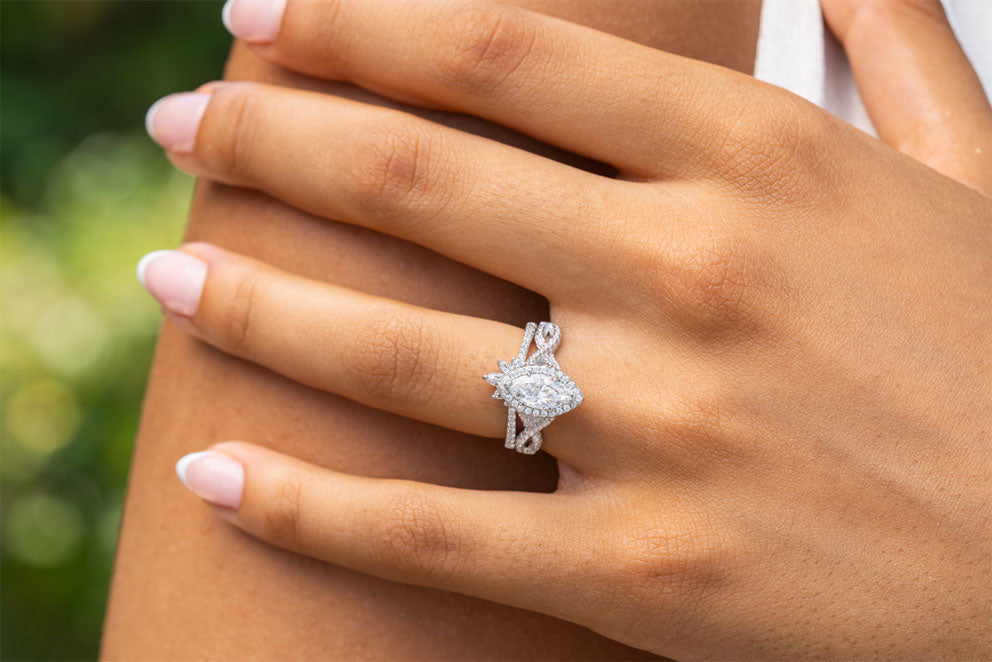
Statement Rings and Bold Designs
The trend of statement rings and bold jewelry designs shouldn’t be limited by size restrictions. Brands can cater to this growing demand by offering inclusive sizing for all ring styles, ensuring everyone can embrace these expressive pieces. This might involve utilizing innovative design techniques, such as adjustable bands or wider shanks, to accommodate a wider range of finger sizes without compromising the aesthetic of the ring.
How Should a Ring Fit?
Finding the right ring fit is essential for both comfort and wearability. But how should a ring fit, exactly? A ring should glide comfortably over the knuckle without feeling loose or restricting movement. It’s important to consider your finger shape and knuckle size when choosing a ring. Individuals with thicker knuckles may require a slightly larger size to ensure the ring fits comfortably over the knuckle without getting stuck. Conversely, those with tapered fingers may need a slightly smaller size to prevent the ring from spinning or falling off.
A well-fitting ring should also feel comfortable throughout the day. It shouldn’t cause any irritation, tightness or restriction of blood flow. If the ring feels loose, it might be wise to consider sizing down or opting for a ring with a snugger band design.
While home sizing methods can provide a starting point, seeking professional assistance from a jeweler is the best way to obtain an accurate measurement and ensure optimal fit. Jewelers have the expertise and tools to measure finger size precisely, taking into account individual variations and ensuring the chosen ring size provides the perfect balance of comfort and security.
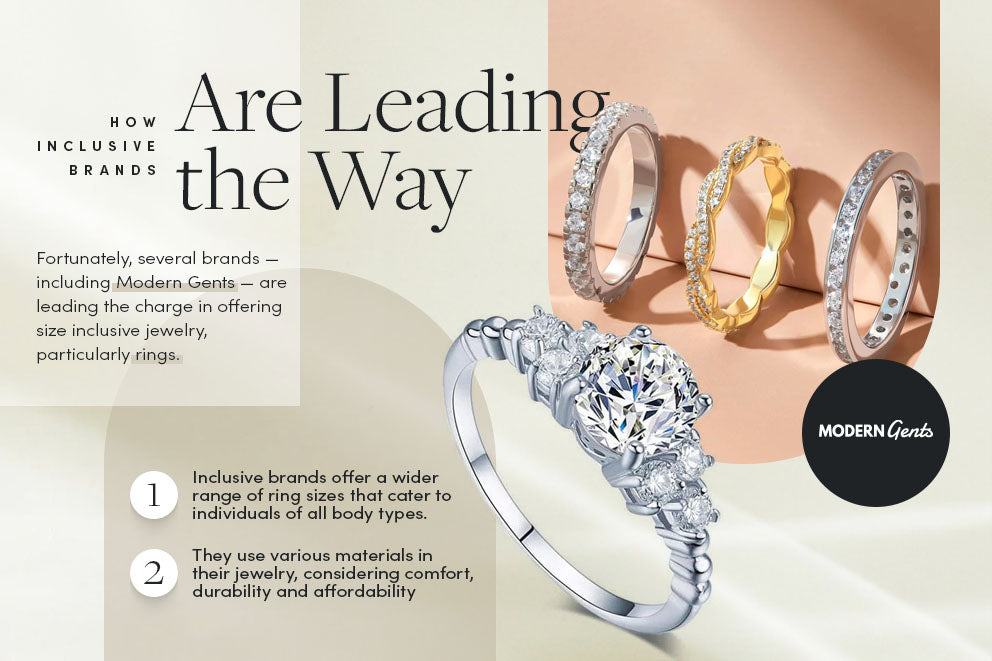
How Size Inclusive Brands Are Leading the Way
Fortunately, several brands — including Modern Gents — are leading the charge in offering size inclusive jewelry, particularly rings. These brands are paving the way for a more equitable and inclusive future in the jewelry industry in several ways.
First, inclusive brands offer a wider range of ring sizes that extend well beyond traditional options to cater to individuals of all body types. This allows for greater accessibility and choice for a wider customer base. These brands also recognize that size inclusivity shouldn’t compromise on style. They offer a variety of design aesthetics, from classic and timeless pieces to contemporary styles, ensuring everyone can find rings that suit their style and align with current trends.
Additionally, they use various materials in their jewelry pieces, considering factors like comfort, durability and affordability to cater to diverse preferences and budgets and make their products accessible. By supporting size inclusive brands, you play a role in encouraging the industry to move toward a more inclusive future where everyone can experience the joy and self-expression that comes with adorning themselves with beautiful jewelry.
The Future of Size Inclusive Jewelry
The growing awareness and demand for size inclusivity in fashion and jewelry are paving the way for a more equitable and empowering future. Technology holds the potential to further expand size options through innovative design solutions and manufacturing techniques. 3D printing, for example, allows for the creation of custom-sized jewelry with intricate details, potentially making size inclusivity more accessible and cost-effective.
As the conversation around size inclusivity continues to gain momentum, you can expect greater awareness and adoption of inclusive practices within the jewelry industry. This will involve not only offering wider size ranges but also fostering a more inclusive and welcoming environment for customers of all body types.
Consumers are increasingly seeking brands that align with their values and prioritize inclusivity. By supporting size inclusive brands, you drive positive change within the industry and help shape a more equitable future for jewelry.
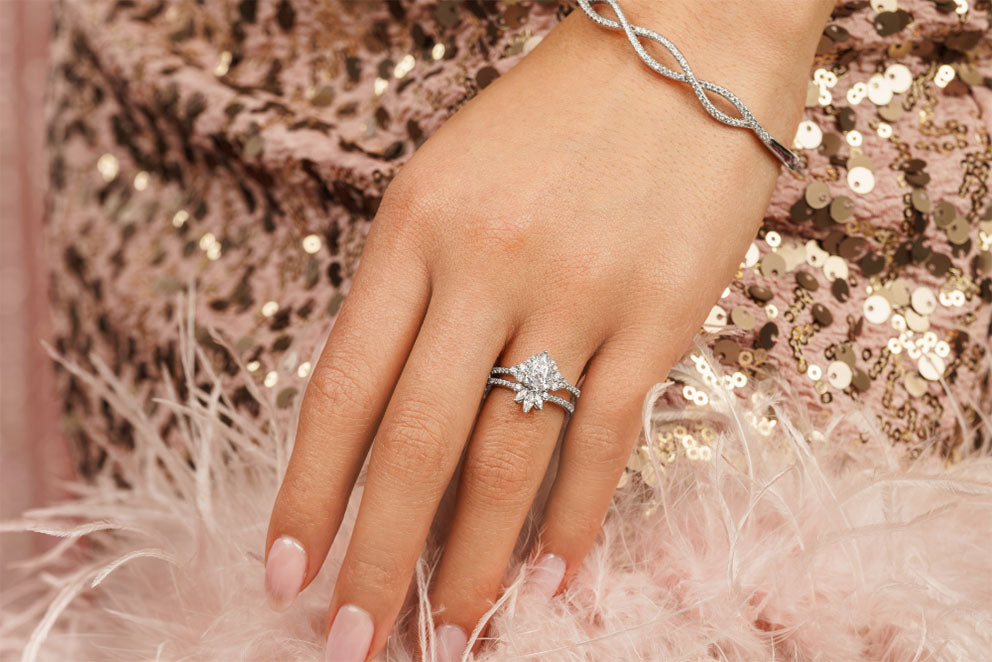
Closing Thoughts
Size inclusivity in jewelry is about so much more than just offering a wider range of sizes. It’s about recognizing and celebrating the diverse beauty of all body types. It’s also about empowering individuals to express themselves through jewelry without limitations and fostering a sense of confidence and self-love. By supporting size inclusive brands, advocating for change and embracing inclusivity in all its forms, we can collectively create a future where everyone can experience the joy and self-expression that comes with adorning themselves with beautiful jewelry.
Image Credits
Artem Varnitsin/Shutterstock.com
